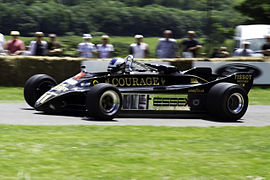Lotus 88

Lotus 88B
|
|||||||||
| Category | Formula One | ||||||||
|---|---|---|---|---|---|---|---|---|---|
| Constructor | Team Lotus | ||||||||
| Designer(s) |
Colin Chapman Martin Ogilvie |
||||||||
| Predecessor | 81 / 87 | ||||||||
| Successor | 91 | ||||||||
| Technical specifications | |||||||||
| Chassis | Twin-chassis construction | ||||||||
| Suspension (front) | Top rocker arms, lower wishbones, inboard springs | ||||||||
| Suspension (rear) | As front | ||||||||
| Axle track | Front: 1,778 mm (70.0 in) Rear: 1,600 mm (63 in) |
||||||||
| Wheelbase | 2,178 mm (85.7 in) | ||||||||
| Engine | Cosworth DFV 2,993 cc (2.993 L; 182.6 cu in) V8 | ||||||||
| Transmission | Lotus/Hewland 5-speed manual | ||||||||
| Weight | 585 kg (1,290 lb) | ||||||||
| Tyres | Michelin/Goodyear | ||||||||
| Competition history | |||||||||
| Notable entrants | Team Essex Lotus | ||||||||
| Notable drivers | 11. 12. |
||||||||
| Debut | 1981 United States Grand Prix West | ||||||||
|
|||||||||
The Lotus 88 was an innovative ground effect Formula One car designed by Colin Chapman, Peter Wright, Tony Rudd and Martin Ogilvie of Lotus in an effort to maximise the downforce produced by ground effects cars.
By 1981 the ground effects cars were so efficient and so fast that the drivers were suffering from the tremendous g-forces involved in cornering and braking. The FIA banned the moveable skirts fitted to the bottom of the cars' sidepods that were vital for achieving consistent ground effect and regulated a mandatory ground clearance of 6 cm, in the interests of driver safety. The Brabham team were the first to circumvent the rules using hydropneumatic suspension systems which compressed under aerodynamic loading and lowered the Brabham BT49 onto the track. This had the side effect of rendering the car without any sort of suspension, causing the driver to be buffeted even more than before. However, the performance gains were such that other teams were soon following suit - although most had difficulty in replicating the Brabham system and used a simple switch to lower the car. Chapman had other ideas.
The earlier Lotus 86 had been designed at the time when skirts were still legal, in the same layout as the 88 but only one prototype had been built. The performance gains were relatively small but significant over conventional ground effects cars. When the skirts were banned, Wright studied the car and its performance without skirts. The loss in performance was largely negligible, so the 88 was quickly designed as a re-engineered 86. The 88 used an ingenious system of having a twin chassis, one inside the other. The inner chassis would hold the cockpit and would be independently sprung from the outer one, which was designed to take the pressures of the ground effects. The outer chassis did not have discernible wings, and was in effect one huge ground effect system, beginning just behind the nose of the car and extending all the way inside the rear wheels, thereby producing massive amounts of downforce. The car was powered by the Ford Cosworth DFV engine. Lotus drivers Nigel Mansell and Elio de Angelis reported the car was pleasing to drive and responsive. To make the aerodynamic loads as manageable as possible, the car was constructed extensively in carbon fibre, making it along with the McLaren MP4/1 the first car to use the material in large quantity.
...
Wikipedia
